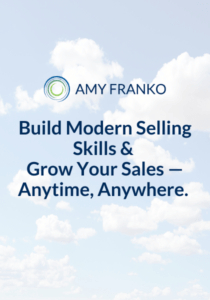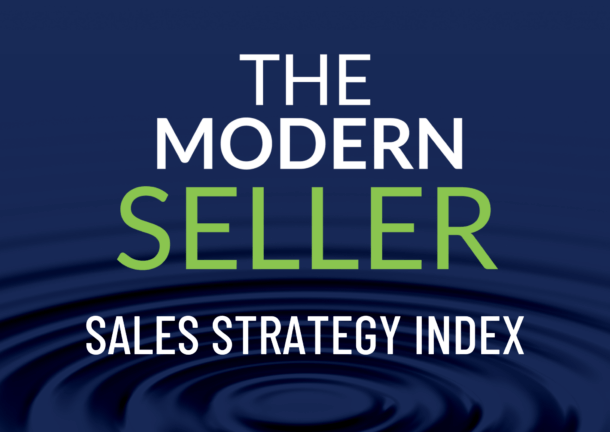By Amy Franko
I’m often asked what has made the greatest impact on my career and entrepreneurial trajectory. The answer is this: the ability to sell, to cultivate and close business.
A passion for selling has always driven me. I began my selling career with IBM, and I’ve since parlayed that experience into other opportunities, both corporate and entrepreneurial.
Of course, much has changed in the sales landscape in recent years. We are seeing shifts in our customers’ habits, processes, and expectations. In turn, we must change the way we approach selling. It affects roles across the organization: field sales, inside sales, pre- and post-sales, marketing, and sales leadership.
In the current climate, our organizations’ success will be dependent on our ability to evolve. This article shares some of my observations on today’s B2B sales environment, a profile of the modern seller, and how the learning function helps sellers connect to increasingly savvy customers.
Breaking Through in B2B
Let’s begin with a look at today’s busy organizational environments. Even with the improved economy, we’re pressured to do more with less. For example, a Gallup survey in 2014 found that the average workweek for full-time employees was 47 hours, not 40. It’s safe to say our sellers are faced with even more workload, and more obstacles to overcome before they can secure new business. Consider these observations:
- Committee-based or group buying decisions are driving account-based relationship models, especially in more complex situations and larger organizations. While it’s critical to have the relationship with the ultimate decision maker, that person often receives input from a committee of influencers. Consider instead an account-level relationship model, whereby multiple relationships are formed across the organization. Account-level relationships are especially important in long sell cycles, because individual “committee members” may move into other roles or be pulled into another initiative and replaced by someone else.
- Customers have ever-increasing expectations, and they are in constant overwhelm. Customers are savvier than ever; they are often well-researched before you engage with them, and they are looking for much more than a transactional experience. It’s a customer experience journey, with meaningful touchpoints occurring before, during, and after an opportunity closes. While those meaningful touchpoints have importance, they are also at high risk of being lost because most people we interact with are operating in a state of overwhelm. Overwhelm taxes the executive-level thinking centers of the brain, and any information that isn’t deemed crucial in that moment is often forgotten.
- Priorities change quickly, putting even “won” deals at risk. Even after making it through the entire sell cycle and winning new business, there is always a risk that the project won’t launch, or the product won’t be implemented. Organizational priorities change at lightning speed due to multiple internal and external factors, and what was critical yesterday may be on today’s chopping block.
- The toughest competitor? Inertia. We all have competitors, those selling similar products and services to our client base. But the competitor I meet most often is an invisible one – inertia, the status quo. Part of Newton’s first law of motion says a body at rest tends to stay at rest. Same is true of organizations. They have an elevated aversion to change, and risk mitigation is here to stay. If “the way we’ve always done it” is good enough, the business case for change becomes even more difficult.
A Profile of the Modern Seller
To succeed in today’s B2B selling environments, a few non-negotiable habits can be applied across the sales profession and for those in learning roles who support sales.
- Entrepreneurial thinking, thought leadership, and attention to personal brand. When I was with IBM, it was easy to get in the door, even with all of the competitive noise in the landscape. My world and mindset radically shifted when my division was sold, and then it shifted again when I became an entrepreneur. Gone were my days of relying on the company logo for credibility. I had to embrace building my personal brand to rise above the rest– developing and sharing expertise through outlets like public speaking, writing, and social media. Today’s seller must operate much like an entrepreneur and thought leader to earn conversations and opportunities with customers.
- Learning agility. In her bestselling book Agile Selling, Jill Konrath makes the case for agile learning, or the “meta skill behind the skill.” To become a differentiator, “you must always be learning. If you are an agile learner, you’re resourceful, adaptable, and proactive.” According to the Institute for the Future at the University of Phoenix, cognitive load management is a key skill of the future workforce (and I would also argue for today’s workforce). We must filter what’s important from vast streams of information, and make meaningful decisions from that information.
- Multi-channel selling. Today’s customers are on information overload, and they have higher expectations than ever before. Our ability to adeptly use multiple channels to interact with them is crucial. It requires a balance across channels such as email, social media, phone, and even text. Using multi-channel selling also implies strategic thinking, being able to see the big picture of an account set or industry vertical to use the right communication strategies.
- Time discipline. This may be the most challenging habit to master, because it means relentlessly protecting our time for critical sales activities. Most of us get lost in a barrage of internal emails, sales team meetings, delivery issues, and day-to-day administration. My best sales mentors had a fantastic ability to protect their calendars and delegate where needed. Even with the “freedom” that comes with being in the field, they created structure to their days, and typically time-blocked to prioritize the most important activities.
Where Does the Learning Function Add Value?
These changes and challenges are also opportunities for the learning function to positively impact sales enablement and add value.
Consider implementing these strategies to help today’s seller to bridge the gap with customers:
- Elevate your sales leader as a critical link to overall success. Upskilling your sales leaders to become coaches and mentors is as important, if not more important, than focusing on individual contributors. Like many first-line leaders, sales leaders are often under-invested in—despite the fact that they have the most direct access to those who generate revenue for the organization. Make sure you have curriculum and performance resources that specifically address the sales leader and empower them to coach individual contributors.
- Get out into the field or on the phones. Spend time with those in role, especially if you don’t have a sales background yourself. You will elevate your credibility with sales teams, as well as gain important insights into skill gaps, showing clear opportunities where you can improve sales enablement. Interview those sales teams to get a true understanding of their challenges and what they would find valuable in sales learning.
- Design learning that supports multi-channel selling. Take a critical look at your current learning program. Does it support multi-channel selling? Does it offer a blended approach for continual learning? Is it personalized to meet sellers where they are? Does it offer practical tools that will actually be used in the field by a sales professional? This is where your sales leaders can be your best resource to help you tackle these challenges in designing relevant sales learning.
- Become a curator (and simplifier) of sales effectiveness tools and technologies. If we look at causes of overwhelm on the sales team, technologies frequently rise to the top. There are so many internal and external technologies to master; your sales teams will view a curation of the best tools and technologies as a major time saver and valuable resource. Places to begin your curation include your internal CRM or social network platform.
- Leverage technologies like TinCan API to pinpoint on-demand needs. TinCan is next generation of SCORM, and it changes the way we gather and analyze learning data. It provides access to data beyond the traditional LMS, plus more depth and meaning to the data, enabling us to create better learning experiences within our organizations.
In addition, TinCan captures data points of online and offline learning, plus formal and informal learning experiences. It also enables different and disparate systems to securely communicate, for a much broader picture of learning experiences. For example, imagine being able to leverage data within your CRM to help you to pinpoint specific training training needs for your sales teams, directly affecting behaviors that drive better opportunities.


 Our Strategic Selling signature sales training program is now available online. This online sales learning program is ideal for professional services and B2B sales. Get started with 2 free lessons.
Our Strategic Selling signature sales training program is now available online. This online sales learning program is ideal for professional services and B2B sales. Get started with 2 free lessons.